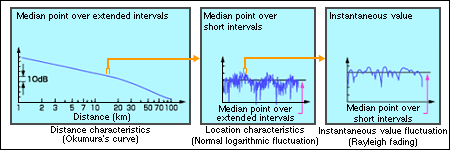Mobile Radio Transmission System -2.Types of Mobile Radio Propagation
Mobile radio propagation is divided into four categories: land mobile radio, aviation mobile radio, maritime mobile radio, and satellite mobile radio. The propagation characteristics of each vary substantially depending on the type of the mobile unit and the condition of the propagation path.
In land mobile radio propagation, radio wave propagation is constantly subject to the influence of obstacles and wave reflection from objects such as buildings, trees and undulations in the terrain. Accordingly, the reception level continuously changes with movement, which can lead to instantaneous drops in the reception level of up to several dozen decibels.
The propagation paths in the aviation and maritime mobile radio propagation contain virtually no obstacles and so are almost equivalent to free space paths. However, because propagation paths can be bent depending on the weather conditions, the air refraction ratio and the earth's spherical shape must be considered when estimating the propagation characteristics.
In case of satellite mobile radio propagation, most of the propagation path lies outside the atmosphere. Despite the substantial propagation loss, the fact that almost no obstacles are encountered means that stable electric field strength can be achieved along the line of sight. However, satellite propagation is still affected by surface reflection from the sea and the shielding impact of buildings, etc., on land.
| Radio wave propagation characteristics | Fading mode | Factor | Principle entities | |
| Instantaneous value fluctuation | Envelope curve fading (Rayleigh distribution) | Non-optional | Multiple wave interference | Median point over short intervals |
| Random FM noise | Time option | Doppler shift | Maximum Doppler frequency | |
| Dispersion of delay | Frequency option | Corridor difference | Delay | |
| Location characteristics (Normal logarithmic fluctuation) | Non-optional | Topography and structures surrounding a mobile unit | Median point and standard deviation over an extended interval | |
| Distance characteristics (Okumura's propagation curve) | Non-optional | Propagation profile | Base station-mobile station antenna height, distance between stations, wireless frequency | |
Radio wave propagation characteristics in terrestrial mobile communications

Radio wave propagation characteristics and factors in terrestrial mobile communications
![]() Created 1999/03
Created 1999/03
